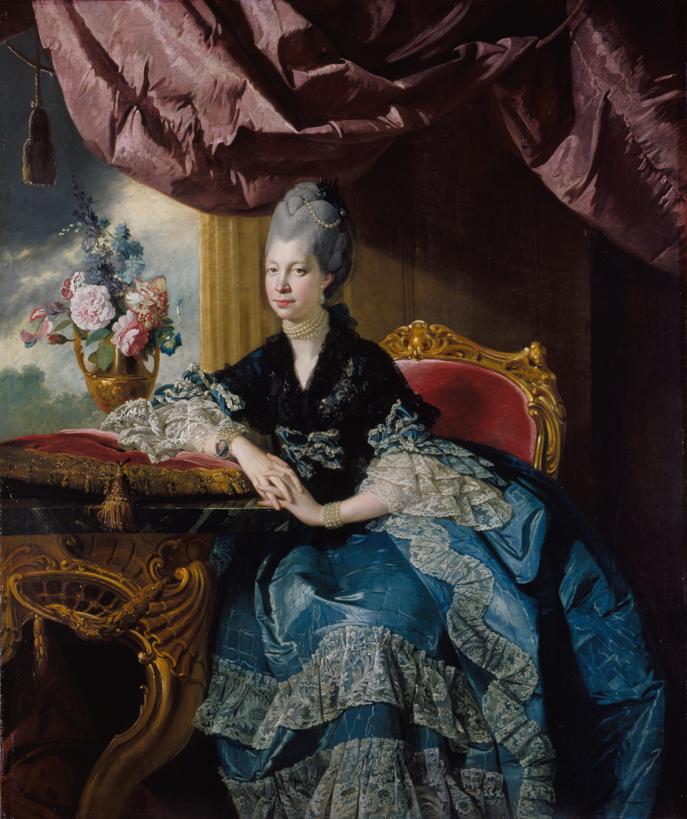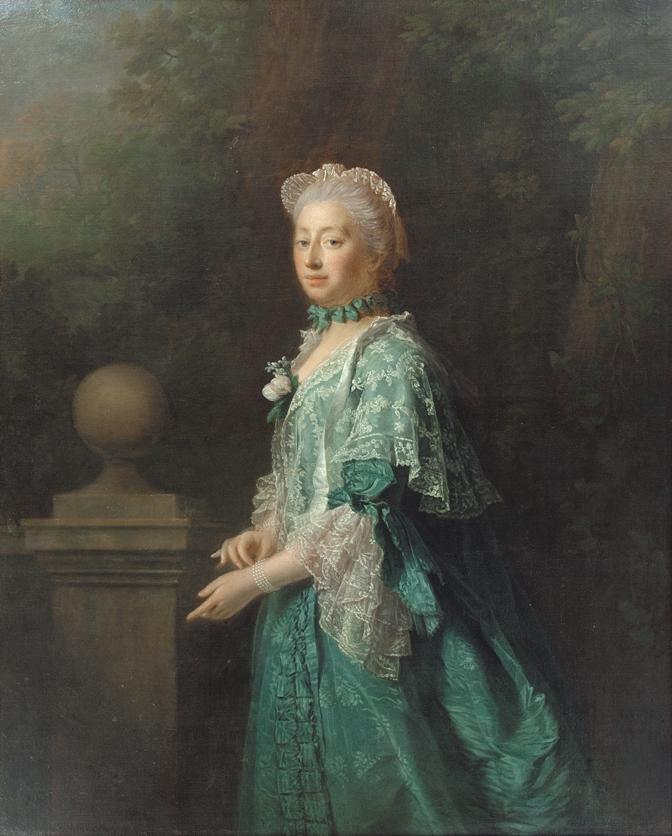

ARt REview
ENLIGHTENED PRINCESSES: Caroline, Augusta, Charlotte, and the Shaping of the Modern World
At Yale Center for British Art, 1080 Chapel St.,
New Haven, through April 30. 877-274-8278, britishart.yale.edu
NEW HAVEN — “Enlightened Princesses: Caroline, Augusta, Charlotte, and the Shaping of the Modern World’’ opens with the visual equivalent of a fanfare: portraits of the namesake royals, all in a row, gobsmackingly large. The paintings are all the more imposing for their ornate gilt frames and the rich burgundy of the wall behind them.
Situated between the portraits are busts of the British kings George II, husband of Caroline, and George III, husband of Charlotte. (Augusta was George III’s mother; her husband, the Prince of Wales, died before ascending to the throne.) Easy to miss, the busts look puny and lifeless compared to the canvases. Point taken: In “Enlightened Princesses,’’ consorts matter more than kings.
The show runs through April 30 at the Yale Center for British Art.
That initial royal array is somewhat misleading. Yes, it’s a sight to gladden the heart of even the most Tory visitor, and in some ways he or she won’t be disappointed by what follows. “Enlightened Princesses’’ features nearly 300 items, drawn from four dozen collections, with more than 80 from the Royal Collection Trust. There are multiple grand portraits of bewigged grandees, not a few of them painted by Thomas Gainsborough or Joshua Reynolds, as well as silk samples and porcelain (some of it Wedgwood) and the future George IV’s baby robe and bonnet. All very “Rule, Britannia,’’ thank you very much.
Yet there are no fewer items suggesting a much more varied and far from triumphalist view of 18th- and early-19th-century Britain. A pocketbook with Charlotte’s needlework implements is at once intimate and mundane. The identity of its owner aside, such a thing is far removed from any fairy-tale view of royalty. Even further removed is Charlotte’s architectural protractor, a selection of contemporary political cartoons, and a video.
Granted, the video shows a historically informed 2014 performance at Hampton Court Palace of a dance composed for Caroline 300 years earlier. But the multimedia presence — there’s also a listening station to hear excerpts from contemporary works by Handel, Mozart, and Haydn, among others — suggests how far afield “Enlightened Princesses’’ can range and how unexpectedly. Smallpox inoculation, the treatment of foundlings, and the importation of exotic animals all figure in the show. That last subject enables inclusion of George Stubbs’s 1763 painting of a zebra, a signature item in the Yale Center for British Art’s collection.
Caroline, Augusta, and Charlotte, daughters of minor German rulers, were women to be reckoned with. Caroline was friends with Leibniz, the foremost German mathematician and philosopher of the day. Her son the king prized Augusta’s political counsel. Charlotte was a great reader (in German, Italian, and French, as well as English). The burden of “Enlightened Princesses’’ is to show how much these women were citizens of the Enlightenment — that adjective in the title isn’t there by chance — playing a role in the cultural, social, and even economic life of their time.
The show’s five themes reflect that emphasis. One looks at the women’s relationship with leading authors, composers, and painters of the time.
“The Court as Stage’’ is both literal (the place of the performing arts in monarchical life) and figurative (the women as actors on the political stage, with the English public as audience).
The consorts’ maternal role is considered specifically, in terms of their own experience of child-rearing, and in a more general sense as mothers of the nation, encouraging charitable activities and the like.
The most ambitious, “To Preserve and Protect: The Princesses and the Wider World,’’ is also perhaps the shakiest, placing the women in the context of the British economy and the nation’s expanding empire.
Finally, there is gardening, which encompasses everything from literal landscaping to quasi-global concerns. A wall label refers to “Augusta’s Gardens at Kew as the Entrepot of Empire.’’ That definite article is a bit startling.
Oohing and aahing over country houses and court ceremony has been left far behind. Splendid artworks have not. A pair of Holbein portrait drawings from the Royal Collection are reminders of Caroline’s discovery of a set of them “lying in a drawer in Kensington Palace,’’ as Lisa L. Ford puts it in the show’s formidable catalog, which has more than two dozen contributors. The drawings are as simple as an orrery is elaborate. An orrery? It’s a mechanism for demonstrating the positions and paths of the planets: part Scientific Revolution, part kinetic art. The show includes one, c. 1740, of oak, brass, and ivory that nods to Caroline’s Great Orrery, also in Kensington Palace. In its more practical way it’s nearly as much of a marvel as the Holbeins.
Equally large in size and reach, “Enlightened Princesses’’ never seems overwhelming. That’s owing in large part to how cannily the show has been laid out, in a series of small temporary galleries that keep even so multitudinous a display feeling manageable. It’s not unlike an orrery that way, only better. It requires no crank for operation.
ENLIGHTENED PRINCESSES: Caroline, Augusta, Charlotte, and the Shaping of the Modern World.
At Yale Center for British Art, 1080 Chapel St., New Haven, through April 30. 877-274-8278, britishart.yale.edu
Mark Feeney can be reached at mfeeney@globe.com.



